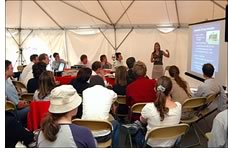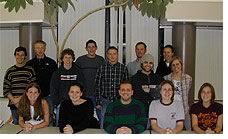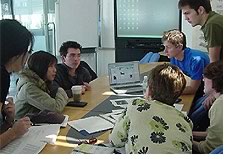

02/2005
 by Russell Boniface
by Russell Boniface
The Beatles once crooned “sun, sun, sun, here it comes.” And, indeed, the sun is coming for 19 university and college teams who believe the energy benefits of a bright sunshiny day are as clear as the blue sky. A 10-day event called the Solar Decathlon will be held October 7–16 in Washington, D.C., to give these 19 schools a showcase to demonstrate the benefits of solar power. Rather than arrive with scores of slide presentations and podiums, each team will arrive at the Capital Mall, not far from the Smithsonian Air and Space Museum, with plans to construct a livable solar house. The 19 houses, each about 800 square feet, will form a mini-Main Street of solar-powered homes.
Rising sun
The event, the first of which took place in 2002, is sponsored by the
AIA, the U.S. Department of Energy’s Office of Energy Efficiency and
Renewable Energy, the National Renewable Energy Laboratory, BP, and
the National Association of Home Builders. “Solar energy technologies
are clean, renewable, and reduce pollutant emissions,” says DOE
spokesman Tom Welch. “The Solar Decathlon serves to push research
and development of energy efficiency and energy production technologies
and raise its awareness among the public and students.”
 The competition
brings public attention specifically to photovoltaic technology. “The
competition is important because it shows people—the
public, professionals, and engineers—that solar is going to become
mainstream one of these days,” says Professor Julee Herdt, Assoc.
AIA, of the University of Colorado. “One of the main things we
learned from the last competition is that the public is ready for renewable
energy design. They’re very curious. There was a huge cross-section
of Americans at the Mall to see these houses.”
The competition
brings public attention specifically to photovoltaic technology. “The
competition is important because it shows people—the
public, professionals, and engineers—that solar is going to become
mainstream one of these days,” says Professor Julee Herdt, Assoc.
AIA, of the University of Colorado. “One of the main things we
learned from the last competition is that the public is ready for renewable
energy design. They’re very curious. There was a huge cross-section
of Americans at the Mall to see these houses.”
The burgeoning solar home market in the U.S. is noteworthy. For example, right now in Lakeport, Calif., alone, a community of 90 energy-efficient solar homes is being built, according to the DOE.
Building the Solar Village
Although the Solar Decathlon is a friendly competition, teams need to
know their stuff and strut their stuff. The teams finance their energy-saving
house through solicited financial donations and also acquire donations
of materials such as tools, wood, and appliances from local contractors.
Some schools hold competitions to determine its winning design. Once
the design is determined, each team has to build its solar house, power
and operate it, spread the word about it, get it to D.C., roll it out,
and finally show it off—inside and out—to a panel of judges who will
scrutinize its functionality and aesthetics.
 Teams such as the University of Maryland will begin their initial construction
this March, with the goal of having it completed by July to provide a
few months to test the house and refine the performance. Mike Binder,
the school’s student team leader, believes the competition is rewarding. “We
believe in the future of solar power and sustainable design,” he
says. “It’s great to work on a project and see something
get built.”
Teams such as the University of Maryland will begin their initial construction
this March, with the goal of having it completed by July to provide a
few months to test the house and refine the performance. Mike Binder,
the school’s student team leader, believes the competition is rewarding. “We
believe in the future of solar power and sustainable design,” he
says. “It’s great to work on a project and see something
get built.”
Design and livability are ranked first on the Decathlon judges’ list. Teams are then required to perform everyday household functions in their solar house for 10 days to prove it works. This includes cooking meals; washing clothes; maintaining comfortable levels of heat, air conditioning, and water temperature; operating lighting and battery power at the correct levels; and running a home office and other appliances such as the television. Students even run a Web page and publish a newsletter. Students also must charge and operate their own electric car, using surplus power from the house.
 Living under the sun
Living under the sun
Architects are taking note. What should they consider when designing
a livable solar home? Professor Matthew Taylor of Washington State
University, one of the participating teams, thinks architects need
to exceed building construction standards relating to energy when designing
a solar house. “Exceeding ASHRAE 90-1 and perhaps doubling it
is a good starting point,” he says.
Professor Stephen Lee, AIA, of Carnegie Mellon University, believes architects needs to consider the passive performance approach to homes and building before considering any solar technology. “A homebuilder plunks PV panels on the roof and sells a ‘solar’ home . . . this is a costly, and ineffective solution,” he explains. “Optimize and integrate the passive performance for heating, cooling, ventilating, and lighting first, before considering any solar technology.”
Siting the house is important for architects to consider in getting the maximum amount of solar radiation onto its panels, according to Binder. “Solar design does have some limitations and requirements in terms of angles of the solar panels, which drives your roof shape to some extent,” he says. “But solar is only part of a much bigger picture . . . which is the idea of sustainable design and passive design. It’s part of a bigger package.”
New technologies emerging
Once architects set aside the budget for solar, they should consider
which way to go. Transparent solar collectors, such as awnings, skylights,
and windows are helping architects and designers create new aesthetics.
Even solar skins are in the mix. “A solar skin is a flexible
PV skin, like a credit card in your pocket, but in 2002 [for the first
Solar Decathlon] they weren’t as efficient as they are now, so
if you were using them you were investing in an expensive system not
as efficient as a rooftop system—but it might have looked better,” Lee
says. “In the 2005 Decathlon those PV skins are available—a
transparent, flexible skin that has a very high efficiency.”
Likewise, the 2002 Solar Decathlon yielded certain other solar technologies that are now off the shelf. Taylor mentions photovoltaic conditioning gear, inverters, and charge controllers as other examples. Binder points out that solar PV panels can be aesthetic and don’t have to be ugly add-ons, commenting that PV arrays can be integrated with glass that can be used as overhangs, canopies, windows, or standard metal-seam roofs. “You can even buy PV cells meant to mimic the look of roofing shingles,” he says. “Most of this stuff has really just started being marketable from a cost and availability standpoint, but there are products comparable in terms of appearance with what people can get in conventional materials. I think what you’re going to see over the next few years is increased performance and lower cost.”
 Lee explains that “right now the products are not in wide distribution,
require special technicians for installation, and are not automatically
integrated with existing systems.” But he does predict a sunny
future for solar house technology. “There will be integrated packages,
so homebuilders will be able to purchase and install a complete, well-integrated,
tested package for PV or solar domestic hot water or solar space heating.”
Lee explains that “right now the products are not in wide distribution,
require special technicians for installation, and are not automatically
integrated with existing systems.” But he does predict a sunny
future for solar house technology. “There will be integrated packages,
so homebuilders will be able to purchase and install a complete, well-integrated,
tested package for PV or solar domestic hot water or solar space heating.”
More power to you
Are power companies happy about solar homes? Taylor thinks so and believes
it’s in a power company’s best interest for a solar home
to be connected to its power grid. “Renewable energy can displace
electrical generation capacity,” he says. “Power companies
don’t have to build a new power plant. A solar home actually
supplies power to the grid when nobody is home. It helps level out
the load profile. If there’s a huge air conditioning load, the
power companies don’t have to pour more water in their dams or
coal on the fire.”
Lee agrees. “With deregulation, the power companies will make a decent return on investment from homeowner solar systems by charging for distribution and connection to the grid. In regions at or near generation capacity, ‘incentivizing’ PV installations can eliminate the need for new power plants.”
Herdt says that solar homes can be anywhere from 10–20 percent more costly, but that’s starting to fade. “You have to look at the payback time. The initial installation cost of these systems will balance out with the savings on energy bills, maybe about five years.”
She mentions that some power companies buy power back but others don’t. “It totally depends on your power company. That’s something that an architect needs to check out. Make sure the client can sell power back to their local utility. If they can’t, then a battery system can be considered that’s not involved with the power company at all.”
Sunnyside up
The energy surrounding this year’s solar decathlon is eclipsing
its 2002 debut. With so much buzz, the future of solar technology looks
bright.
“The competition has a fun atmosphere, and it’s really nice to see competing schools visiting each other,” says Herdt. “All the schools are working together to promote something we really believe in. The main thing is to make solar energy part of everyday life. That’s our goal with this competition.”
Although the event is a lot of hard work for its participants, the Solar Decathlon promises to be a lot of fun in the sun for the teams and the public alike.
Copyright 2005 The American Institute of Architects.
All rights reserved. Home Page ![]()
![]()
